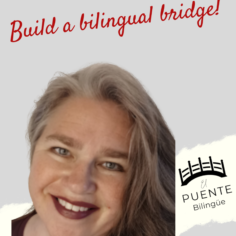What is behind the Montessori-inspired curriculum as well as my mainstream/conventional curriculum? What kind of research supports what I’m doing?
To explain all of this I made a playlist about best practices for language acquisition and learning. It now features 6 videos. The first 5 videos take you on a journey to explore options for language learning for conventional and Montessori students. The final video cuts to the chase and gives an overview of the Montessori materials and the research behind it.
Feel free to skip to the video that you most want to watch, using the spoilers I have included above each video.
The videos progress as follows:
1) We meet 4 students and find out who is most likely to become bilingual first. Then we narrow our conversation to 2 students – those who would take a bit longer to learn a second language, but still get there.
CLICK FOR PART ONE: Let’s get started!

2) PART TWO In the second video we talk about some of the differences between Demetri’s conventional elementary school learning experiences versus Clarissa’s Montessori experience, and what they may mean for potential growth as a second language learner.
3) This video focuses on Demetri, who is in a conventional school. Insight, suggestions and ideas are given regarding options for learning Spanish, not only for Demetri but for his siblings, too! Let’s find out how Demetri can maximize his Spanish language learning potential.
4) In the 4th video we look at Clarissa’s Montessori education and what difference it can make for her if she decides to learn Spanish. But wait! Is there something missing from the possible approaches? For Clarissa’s continued story, Click here- Video A, but be warned…there is a cliff hanger at the end!
5) Here we find out what is missing from Montessori curriculum when it comes to second language learning. We consider best practices as well as what Clarissa already has in place as a result of her Montessori education. We find out what role El Puente Bilingüe may have to play in her situation. Click here on Video B to find out what was missing from the Spanish language-learning curriculum and how we are going to fix that!
6) This video offers an overview of what El Puente Bilingüe has to offer Montessori communities. Perhaps your school would like to work with me to help your young students develop language learning skills. If so, please reach out! My email is puentebilingue@gmail.com

IMAGINE using these materials in your Montessori learning environment, and supporting your language learners!
If you would like to support the production of Montessori-inspired Spanish language learning materials through donation, please visit https://shop.elpuentebilingue.com and scroll down to “support El Puente Bilingüe. ¡GRACIAS!

El Puente Bilingüe curriculum for independent learners and the Montessori community can be found at https://shop.elpuentebilingue.com
El Puente Bilingüe curriculum for mainstream Spanish teachers is located at my Teachers Pay Teachers store!
Thank you for taking the time to learn what El Puente Bilingüe has to offer!

References
Chomsky, Noam (2007). “Approaching UG from Below”. In Hans-Martin Gärtner; Uli Sauerland (eds.). Interfaces + Recursion = Language? Chomsky’s Minimalism and the View from Syntax-Semantics. Studies in Generative Grammar. Berlin: Mouton de Gruyter. ISBN 978-3-11-018872-1.
Dewey J. (1938). Experience and education. Macmillan.
Freire, P. (2000). Pedagogy of the oppressed (30th anniversary ed.). Continuum.
García, O. (2009). Chapter 8 Education, Multilingualism and Translanguaging in the 21st Century. In T. Skutnabb-Kangas, R. Phillipson, A. Mohanty & M. Panda (Ed.), Social Justice through Multilingual Education (pp. 140-158). Bristol, Blue Ridge Summit: Multilingual Matters. https://doi.org/10.21832/9781847691910-011
Hornberger, N. H. (1989). Continua of Biliteracy. Review of Educational Research, 59(3), 271–296. https://doi.org/10.3102/00346543059003271
Hornberger, N. H. (2004). The Continua of Biliteracy and the Bilingual Educator: Educational Linguistics in Practice. Retrieved from https://repository.upenn.edu/gse_pubs/9
Krashen, S. D. (1982). Principles and practice in Second language acquisition. Pergamon Press.
Montessori, M. (2019). Citizen of the world: Key montessori readings. Montessori-Pierson Publishing Company.
Ringbom, H. Ì. A. (2007). Cross-linguistic similarity in foreign language learning. Multilingual Matters.
Vygotsky, L. S. (1978). Mind in society: The development of higher psychological processes Cambridge, Mass.: Harvard University Press.




